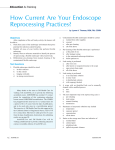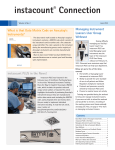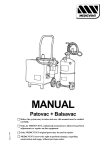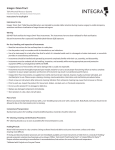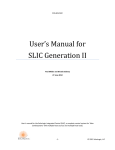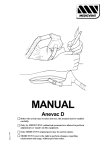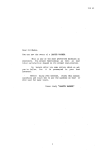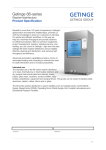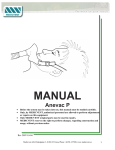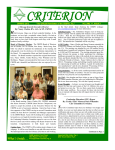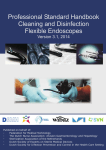Download Washer monitoring: A must-have for today`s best practices (Part 2)
Transcript
sELf-sTudy sERiE November 2012 The self-study lesson on this central service topic was developed by STERIS. The lessons are administered by KSR Publishing, Inc. Earn CEUs The series can assist readers in maintaining their CS certification. After careful study of the lesson, complete the examination at the end of this section. Mail the complete examination and scoring fee to Healthcare Purchasing News for grading. We will notify you if you have a passing score of 70 percent or higher, and you will receive a certificate of completion within 30 days. Previous lessons are available on the Internet at www.hpnonline.com. Certification The CBSPD (Certification Board for Sterile Processing and Distribution) has pre-approved this in-service for one (1) contact hour for a period of five (5) years from the date of original publication. Successful completion of the lesson and post test must be documented by facility management and those records maintained by the individual until re-certification is required. DO NOT SEND LESSON OR TEST TO CBSPD. For additional information regarding certification contact CBSPD - 148 Main Street, Suite C-1, Lebanon, NJ 08833 • www.sterileprocessing.org. For more information direct any questions to Healthcare Purchasing News (941) 927-9345, ext 202. Learning Objectives 1. Understand the different methods of washer monitoring in the reprocessing department. 2. Discuss the washer monitoring recommendations of industry guidance organizations. 3. Discuss how to implement a monitoring process based on guidance and standards. sELf-sTudy sERiEs Sponsored by Washer monitoring: A must-have for today’s best practices (Part 2) by Zak Harty and Lindsay Benz W asher monitoring has improved in recent years. Like most products in the world today, washerdisinfectors have more technology built in than ever before. This technology allows the washer-disinfector to provide useful information to the user and the department manager about the cycle and any errors or faults that occur. It gives the user more assurance that the critical process parameters are maintained during a cycle, and that the conditions were right for cleaning and disinfection to occur. Once a washer-disinfector is installed in a sterile processing department, there are a number of monitoring activities and practices that can be employed. Additional technologies are also available that allow a system to be remotely monitored. Any detected issues can elicit proactive service to maximize uptime and minimize negative impact to the department. Preventative maintenance also serves as a means to monitor this type of equipment. Having a trained set of eyes inspect the equipment for signs that parts need to be replaced can extend the life of the unit and reduce the likelihood that emergency service will impact the department. In addition, the standards and recommendations provided by key professional and regulating bodies for washer-disinfectors offer information to both the manufacturers and the users of these systems. This gives the user extra reassurance that the conditions were right for cleaning and disinfection to occur, and guidance to the department to help them verify that the process was completed effectively. The end result of thorough washer-disinfector monitoring is a more efficient department and better outcomes for patients. Remote diagnostic monitoring Washer-disinfectors often provide information to the user by sounding or displaying alarms and warnings. Although the washer’s user manual may indicate the process to follow if the washer alarms or issues a warning, many times the manual is not immediately available or the alarms and warnings may go unnoticed in a busy department. As an adjunct to departmental observation, some systems come equipped with web-based connectivity that allows linkage to a remote diagnostic monitoring service. A 24/7 monitoring service can help keep track of alarms, warnings or cycle aborts, and will notice patterns consistent with a part needing replacement, for example. Service center professionals can notify the department if abnormal washer operation is observed, and can dispatch a technician proactively to the department to fix a problem before it renders the washer-disinfector inoperable. Visual inspection – a standard practice As an added level of assurance, reprocessing professionals should visually inspect the instruments after they have been processed in the washer-disinfector. As AAMI states, The extra assurance of validated cycles Sponsored by: All of these important parameters need to be within the tolerances determined by the manufacturer for the cycle to be completed effectively; but how does the user know that the parameters were indeed within the limits? Washers with sophisticated PC controls have the ability to accurately, reliably and repeatedly monitor the critical parameters of the cycle, and are “smart” enough to alert the user when there is a risk that the process was not effective. Some washer-disinfector manufacturers offer even more confirmation that these critical process parameters are being met in the standard washer cycle. This assurance is offered in the form of a published validated cycle. The validated cycle documents the scientific testing process and results proving that the washer achieved the cleaning and disinfection results specified in the FDA Special Controls Guidance Document: Medical Washers and Medical Washer-Disinfectors. By comparing the manufacturer’s validated cycle document to the Special Controls Guidance Document, a user can be confident that their washer-disinfector, if used according to manufacturer directions, is doing its job. 30 November 2012 • HEALTHCARE PuRCHAsing nEWs • www.hpnonline.com Self-study series Sponsored by A washer-disinfector test indicator and holder, designed to present a cleaning challenge in the chamber “The most common method [to evaluate the results of the cleaning process] is a visual inspection, sometimes involving the use of a lighted magnifying glass. Healthcare personnel inspect every device for visible organic soil and contamination in a simple functionality check, usually as part of the inspection, preparation, and packaging procedure.”8 Process indicators There are a number of washer indicators on the market today that are designed to monitor the performance parameters of a washer/ disinfector. It is important to understand that these indicators do not indicate whether instruments have been thoroughly cleaned; rather, they verify that critical process parameters have been met in all phases of the cleaning and decontamination cycle. The chemical indicator substrates are often coated with proteins, carbohydrates, lipids and dyes that are designed to represent the soils commonly found on used surgical equipment. These coating formulations are designed to break down and disappear or change color when all of the key washer/disinfector process parameters (including time, temperature, mechanical action (impingement) and cleaning chemistry) have been met through the cleaning and disinfection process. Preventive maintenance One key to assuring optimal daily performance, minimizing downtime, and maximizing equipment life is appropriate maintenance. Performing regularly scheduled maintenance according to the manufacturer’s recommended timeline is actually a way to monitor the washer. By performing thorough preventive maintenance, the hospital biomed professional or original equipment manufacturer service technician can replace the washer’s worn parts before they fail and look for signs of unexpected wear on larger parts, which helps to ensure that the washer is performing at its best. The consequences of forgoing preventive maintenance could be huge. Imagine that a worn part (for example a seal or bushing) fails and causes the washer to abort its cycle during peak processing hours. This puts a strain on the department and could prevent surgical instruments from being turned around in time for the next surgery. Since preventive maintenance is scheduled in advance, it can happen during off-peak hours to help reduce disruptions during the busiest time of the day. Emergency maintenance can also be more expensive. The total cost not only includes the actual cost of the repair and associated parts, but the lost revenue associated with any downtime, the costs for extra labor needed to catch up when the system is back online, and the time wasted when department staff is idle waiting for the unit to be repaired. In addition to avoiding financial consequences, the other important benefit of preventive maintenance is that it puts someone familiar with the washer in front of it at regularly scheduled intervals, to monitor the performance of individual components. The end result is that the washer is less likely to fail when you need it the most. devices have been properly cleaned and disinfected. They stress the importance of regular monitoring of automated washing equipment and suggest that process parameter results be reviewed and documented regularly as part of an ongoing quality management program. AAMI states: “The purpose of cleaning and rinsing is to remove all visible debris from an item and to reduce the number of particulates, microorganisms, and potential pathogens. The accepted standard for the degree of clean is visibly clean.”9 “To ensure that mechanical cleaning equipment is working properly and according to the manufacturer’s specifications, health care personnel may perform verification tests as part of the overall quality assurance program. Methods of verification include the use of devices that directly test individual instruments for residual soils, challenge cleaning effectiveness with standardize test methods, or measure specific key parameters to evaluate the functionality of the cleaning equipment. Mechanical cleaning equipment should be tested upon installation, weekly (preferably daily) during routine use, and after major repairs. Monitoring and verifying cleaning processes should be documented. Some mechanical washers have digital readouts and cycle printouts that should be reviewed for each cycle and initialed. Ideally, cleaned medical devices should be traceable to the patients on whom they are used.”10 They also make this recommendation: As has been stated before, cleaning is a critical step in the sterile processing of reusable medical devices. For this reason, establishing a quality management system that incorporates equipment monitoring is recommended by many healthcare professional organizations. No discussion of washer monitoring is complete without a review of recommendations from these guidance organizations and global standards like the ISO 15883 series. Each has a different perspective, but all offer guidance that can help departments develop washer-disinfector monitoring processes that are compliant and in line with best practices. “After completing the cleaning process, personnel should visually inspect each item carefully to detect any visible soil. Inspection using magnification might identify residues more readily than [with] the unaided eye. Although validation of the cleaning process may not be realistic in health care facilities, verification is possible. Device manufacturers should provide any test procedures that can be easily replicated and that can help users recognize whether cleaning was effective for all device areas. Such tests are particularly important for devices with components that cannot be readily inspected for cleanliness.”11 The AAMI Comprehensive Guide to Steam Sterilization and Sterility Assurance in Healthcare Facilities Annex D Tables 1 & 2 (pg 172-173) provides several verification tests that measure cleaning efficacy. Association for the Advancement of Medical Instrumentation (AAMI) While AAMI acknowledges that visual inspection is the widely accepted standard in the market today for degree of cleanliness, they also provide several suggested verification tests to further validate that medical Association of periOperative Registered Nurses (AORN) AORN helps define the cleaning process and guides healthcare facilities to follow the medical device manufacturer’s instructions for use when determining specific cleaning See Self-Study Series on page 32 Compliance to standards yields best practices Self-Study Test Answers: 1. F, 2. F, 3. A, 4. E, 5. A, 6. E, 7. B, 8. E, 9. E, 10.A www.hpnonline.com • HEALTHCARE Purchasing NEWS • November 2012 31 Self-study series Sponsored by parameters for a given device. They also recommend that departments establish a quality management program to aid in monitoring the ongoing performance of automated washing equipment. They state that: user, “Failure of any sensor in a system controlling disinfection time or temperature shall cause a fault to be indicated.” Again, this gives the user reassurance that when a washer-disinfector that meets the standard finishes a cycle without warnings or faults, the conditions were right for cleaning and for the claimed level of disinfection to occur. This ISO standard also discusses in detail the specific requirements for establishing a cleaning validation, including routine testing. “Washer decontaminator cycles are intended to process instruments and equipment to a level that renders them safe to handle by persons who will inspect and prepare them for terminal sterilization. This type of decontamination equipment can use a single chamber for rinsing, cleaning and drying or can use multiple chambers (i.e. one chamber for each phase of the cycle). These phases can include an initial cool-water rinse to remove protein debris, an enzymatic rinse, a detergent wash, an ultrasonic cleaning, a sustained hot water rinse, a deionized water final rinse, a lubrication rinse, a liquid chemical germicide rinse and a drying cycle. The sequencing and number of stages can vary among manufacturers. The instrument manufacturer’s instructions should be used to determine the amount of time necessary to efficiently clean and rinse the instruments. The operator should ensure that the proper cycle is being used.”12 They continue: “A quality management program should be in place to test mechanical cleaning equipment. Mechanical instrument washers should be tested for proper functioning before initial use, weekly during service, and after major maintenance. Adequate cleaning of surgical instruments is essential to remove or destroy microorganisms and eliminate endotoxins. Testing washer-decontaminators on a regular basis verifies that the equipment is functioning properly or indentifies an opportunity for corrective action. Washer testing products are commercially available.”13 As mentioned previously under the Process Indicators section of this article, these washer indicators monitor the performance of automatic washing equipment by verifying that critical process parameters have been met in all phases of the selected cycle. International Standards Organization The international standard ISO 15883 goes into great detail about the monitoring capabilities that a washer-disinfector must have in order to claim compliance to the standard. The level of detail is too fine to cover every point in this lesson. However there are several key points that warrant attention. The standard focuses heavily on the critical process parameters, “The WD shall be fitted with a means to verify and/or record the attainment of the specified process conditions.”14 Based on the instruments being processed and their terminal process, the standard provides recommendations for the amount of monitoring Ultimately for the patients the washer-disinfector should have, “The nature and extent of monitoring shall be commensurate with the intended use of the load and the risk arising from not detecting a failure to attain the specified value of one or more critical process variables.”15 Three different levels are defined: 1.Verification by the operator of the attainment of thermal disinfection 2.Verification by process record, independent from the controller, of the attainment of thermal disinfection conditions 3.Verification by process record, independent from the controller, of the attainment of those process variables affecting both the cleaning and disinfection processes16 The standard describes sensing locations in the washer-disinfector for the process parameters. It even defines a method of measuring temperature in the chamber, “At least one temperature sensor shall be located in a position which was previously determined as being representative of the lowest temperature achieved within the load. This shall make it possible to determine that all surfaces which are required to be disinfected throughout the load and chamber will attain the disinfection temperature for the required time.”17 This gives the user additional reassurance that the temperature achieved during the thermal rinse phase is sufficient for the claimed level of disinfection to occur. However, if a sensor were to fail during the cycle, the standard gives guidance for the washer-disinfector’s ability to notify the 32 November 2012 • HEALTHCARE Purchasing NEWS • www.hpnonline.com When the ultimate goal of a washing and disinfection protocol in a reprocessing department is to reduce the risk of infection and other adverse reactions in patients, then all guidelines, standards and monitoring options must be considered in order to design the optimal cleaning policies and procedures for the facility. In the two parts of this self-series lesson, we have attempted to provide an overview of the most current monitoring capabilities and the multiple options and resources available to sterile processing departments. By selecting quality systems with automated monitoring options and applying available guidance and standards, healthcare providers can incorporate the monitoring capabilities that support departmental best practices and maximize patient safety. hpn Zak Harty is a product manager for washing systems at STERIS Corporation, with responsibilities for overseeing product development, sales and marketing. He has also served as a product manager for STERIS surgical solutions, and has an extensive background in design engineering, application engineering and test engineering in various industries. Harty holds a Bachelor of Science in Mechanical Engineering from Rensselaer Polytechnic Institute. Lindsay Benz is a product manager in the Infection Prevention Technology division of STERIS Corporation. She is responsible for managing product development, sales and marketing for single chamber, multi-chamber and cart washers and their accessories. She has experience as a product development scientist at manufacturing companies in multiple industries. Benz holds a Bachelor of Science degree in Engineering Management from Miami University. Self-study series Sponsored by References Facilities, AAMI ST79:2006, p. 55, 58, 97, 169. 1.References 1-5: Food and Drug Administration/Office of Device Evaluation. Class II Special Controls Guidance Document: Medical Washers and Medical Washer-Disinfectors; Guidance for the Medical Device Industry and FDA Review Staff, FDA, Rockville, MD, USA, February 7, 2002, Forward and PP. 27-30. 3. References 12, 13: AORN Perioperative Standards and Recommended Practices, 2012 Edition, Recommendation, p. 521, 533. 4.References 14-17: International Standards Organization, 15883 Washer-disinfectors – Part 1: General requirements, terms and definitions and tests, 2006 Edition, P. 20, 21. 2. References 6-11: AAMI Comprehensive Guide to Steam Sterilization and Sterility Assurance in Healthcare Continuing education test • November 2012 Washer monitoring: A must-have for today’s best practices Part Two Circle the one correct answer: 1. Process indicators for washers are designed to: a. Monitor the performance parameters of a washer b. Determine whether instruments processed in the washer are clean c. Represent the clinical soils found on used surgical instruments d. Break down or change color e. All of the above f. a, c and d 2. There are several ways to monitor washerdisinfector performance, including: a. Verification of critical process parameters by the control program b. Visual inspection of instruments c. Remote diagnostic monitoring and preventive maintenance d. Washer process indicators e. a and b f. All of the above 3. A published validated cycle documents the scientific testing process and results proving that a washer achieved the cleaning and disinfection results specified in the FDA Special Controls Guidance Document. a. True b.False 4. Remote diagnostic monitoring is: a. An adjunct to observation by department staff b. A 24/7 web-based monitoring service c. A method for identifying a part that may be wearing out d. A way to dispatch a technician proactively e. All of the above 5. Performing regularly scheduled maintenance on a washer according to the manufacturer’s recommended timeline is actually a form of monitoring. a. True b. False 6. The consequences of forgoing preventive maintenance could be serious because: a. A worn part could fail and cause the washer to abort its cycle during peak processing hours, which could prevent surgical instruments from being turned around b. Emergency maintenance can be more expensive, and the total cost includes the actual cost of the repair and parts, the lost revenue associated with any downtime, the costs for extra labor needed to catch up when the system is back online, and the staff time wasted when technicians are idle waiting for the unit to be repaired. c. Without preventive maintenance at regular intervals, the washer is more likely to fail when you need it the most d. a and c e. All of the above 7.According to AAMI guidance, mechanical cleaning equipment should be tested upon installation, hourly during routine use, and after major repairs. a. True b.False 8. ISO sets forth several types of verification for critical process variables. They include: a. Verification by the operator of the attainment of thermal disinfection b. Verification by process record, independent from the controller, of the attainment of thermal disinfection conditions c. Verification of standardized test methods d. Verification by process record, independent from the controller, of the attainment of those process variables affecting both the cleaning and disinfection processes e. a, b, and d f. All of the above 9. Washer indicators: a. Verify that critical process parameters have been met in all phases of the cleaning and decontamination cycle b. Are often coated with proteins, carbohydrates, lipids and dyes designed to represent the soils on used surgical equipment c. Are designed to disappear or change color when all key washer/disinfector process parameters have been met in the cleaning and disinfection process. d. Indicate that instruments are clean e. a, b, and c 10.When a washer-disinfector that meets the ISO standard finishes a cycle without warnings or faults, the conditions were right for cleaning and for the claimed level of disinfection to occur. a. True b.False Presented by Request for Scoring o I have enclosed the scoring fee of $10. (Payable to KSR Publishing, Inc. We regret that no refunds can be given. Multiple submissions may be submitted in bulk and paid with a single check for the bulk sum.) Sponsored by Detach exam and return to: Continuing Education Division KSR Publishing, Inc. 2477 Stickney Point Road, Suite 315B Sarasota, FL 34231 PH: 941-927-9345 Fax: 941-927-9588 Please print or type. Return this page only. Name Title Hospital Name Mailing Address Apt/Suite City, State, Zip Daytime Phone E-mail www.hpnonline.com • HEALTHCARE Purchasing NEWS • November 2012 33




